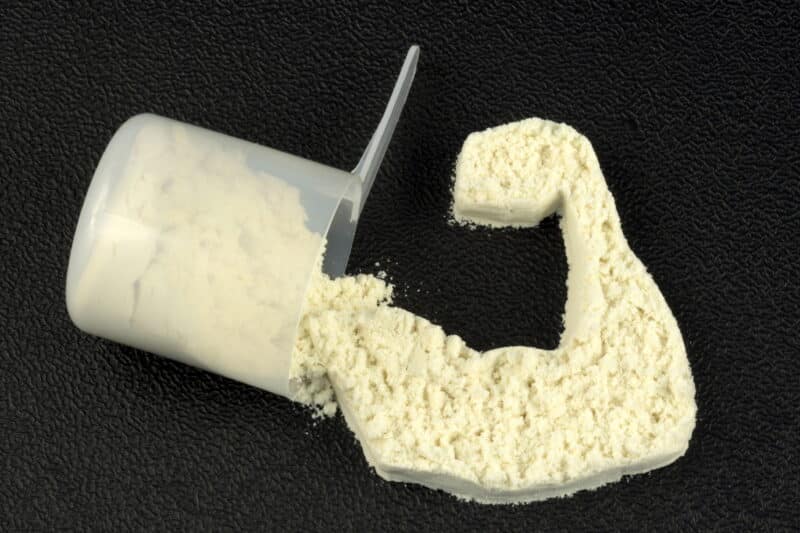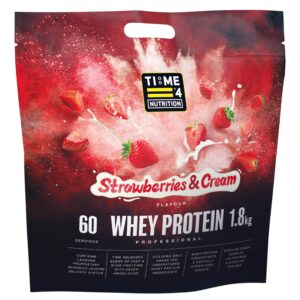The Benefits of a Time Released Whey Protein Formula
The Benefits of a Time Released Whey Protein Formula
Timed Released Whey Protein – Superior Absorption
It is often said that the secret to success in many things in life, from comedy to business and sport, is timing. Timing also plays an important role in optimising our nutritional status for both health and performance. For example, endurance athletes will take great care to ensure that they consume particular types of carbohydrate at specific times to maximise their glycogen stores prior to an event. They will also consume carbohydrate at predetermined times during the race to ensure their working muscles have a constant supply of their preferred fuel to optimise performance.
When it comes to protein, the approach employed by many people is to consume as much as possible with little thought given to timing or the rate at which different forms of protein are released and absorbed by the body.
However, this is now changing, as the effects of different types of protein and the use of ‘fast’ and ‘slow’ proteins to achieve optimal results have become the subject of scientific investigation.
This has led the International Society of Sports Nutrition (ISSN) (21) to recommend that in order to maximise muscle growth and maintenance, we need to consume 0.25g of a high-quality protein per kg of body weight, or an absolute dose of 20-40 g. These protein doses should ideally be evenly distributed, every 3-4 hours, across the day and should contain 700-3000mg of leucine and/or a higher relative leucine content, in addition to a balanced array of the essential amino acids (EAAs).
The ISSN suggest that rapidly digested proteins that contain high proportions of essential amino acids (EAAs) and adequate leucine, are most effective in stimulating muscle protein synthesis. However, the ISSN also recommends the consumption of the slower acting casein protein at certain times to increase muscle protein synthesis.
Confused? Don’t be. All will be explained as we look at ‘fast’ and ‘slow’ acting proteins and how they can benefit you.
We’ll begin with the fast-acting whey protein.

The Benefits of a Time Released Whey Protein Formula: Whey Protein
Whey protein is the protein fraction of whey, the liquid portion of milk that separates from the curds during the cheese making process. It comprises 20% of total milk protein and is rich in branch chain amino acids and essential amino acids, functional peptides, antioxidants and immunoglobulins (17).
It is a complete, high-quality, easily digested protein which has been shown scientifically to provide numerous potential benefits for health and performance. These include increasing muscle mass (1,12,15,16,21) reducing body fat (1, 2, 4, 21) helping to maintain muscle mass during weight loss (4), supressing appetite to aid fat loss, increasing metabolism (2), improving immune function, reducing blood pressure (5), reducing unhealthy blood fats (7), improving blood glucose levels in type 2 diabetics, and increasing the production of glutathione, the body’s master antioxidant (8). It also confers benefits against a wide range of metabolic diseases such as cardiovascular complications, high blood pressure, obesity, diabetes, cancer and phenylketonuria (17).
How Does Whey Protein Compare to Other Protein Sources?
Having reviewed the data supporting the role for whey protein consumption in the regulation of muscle mass and body composition, Devries and Philips (18) concluded that whey protein is one of the highest-quality proteins, given its amino acid content (high essential amino acids, branch chain amino acids, and leucine content) and rapid digestibility. They further suggest that whey protein has the ability to stimulate muscle protein synthesis to a greater degree than other proteins.
The Benefits of a Time Released Whey Protein Formula: Whey Protein Isolate Versus Whey Protein Concentrate
There are various types of whey protein, which differ slightly in the processing they have undergone, their composition and the benefits they provide. Two of the most popular forms are whey concentrate and whey isolate.
While both whey isolate and whey concentrate are great sources of complete protein, providing you with all of the amino acids you need to build and maintain a lean, muscular physique, and both increase the release of anabolic hormones, they are slightly different. Therefore, each can provide particular benefits.
Whey concentrate and whey isolate undergo several processing steps to increase their protein content. After a sufficient protein concentration is achieved, the liquid can be dried to form whey concentrate powder.This comprises up to 80% protein by weight and is typically low in fat and cholesterol and contains bioactive compounds as well as growth factors and small amounts of carbohydrates in the form of lactose. It is also rich in both branch chain amino acids (BCAAs) and glutamine. In comparison to other protein sources, such as meat, whey concentrate is quickly absorbed by the body, although not as quickly as whey isolate.
Whey isolate goes through a more intense processing phase than whey concentrate. This removes virtually all of the carbohydrates and fat yielding highly pure protein content of 90% or more by weight. It is also more quickly absorbed by the body than whey protein concentrate.
Although the processing steps used in the production of whey isolate result in a higher protein content, they also result in a reduction in some bioactive compounds and growth factors and lower levels of carbohydrates, lactose and fat than whey concentrate. Therefore, combining both whey isolate and concentrate provides you with benefits of each, both in terms of nutritional content and variation in absorption and release of amino acids.

The Benefits of a Time Released Whey Protein Formula: What is Casein protein?
While whey comprises 20% of milk protein, casein accounts for remaining 80%. Like whey protein, casein is a complete protein which provides all of the essential amino acids the body needs for growth and repair (9).
There are two main forms of casein protein. These are casein hydrolysate, which is pre-digested and rapidly absorbed, and micellar casein.
In contrast to whey protein’s rapid digestion, micellar casein protein is referred to as a ‘time-release’ protein because it is digested slowly, feeding your muscles with amino acids at a low level over a period of up to 8 hours after consumption to ensure optimum growth and recovery (10,11).
This makes it ideal to take before bed when it can reduce muscle breakdown as you fast overnight. In short, this means that your muscle cells are able to synthesise protein during times when your body might normally be breaking down its own muscle tissue. Consequently, this ability of micellar casein protein has led to it being referred as ‘anti-catabolic’.
It is important to note that micellar casein protein isn’t just for consumption at night; with its slow release of critical nutrients, it is ideal for consumption at breakfast, bedtime and any situation that involves short-term fasting.
For example, it is recommended that we consume high quality protein every 3-4 hours across the day to maximise muscle protein synthesis (21); however, this is often difficult due to the demands of modern life. You may have your breakfast at 6am and then be unable to consume the requisite amount of protein until 12pm. This is a full six hours of fasting. In these situations, micellar casein protein can provide you with that gradual supply of essential amino acids and other important nutrients.
Just How Effective is Consuming Casein Protein Before Bed?
A study by Snijders and colleagues (20) assessed the impact of casein protein supplementation before sleep on muscle mass and strength gains during a resistance training programme. The results of the study showed that those subjects consuming a casein protein supplement before bed increased type 2 muscle fibre size by 8.4 cm2 compared to 4.8 cm2 in the placebo group. The study also found the casein group achieved significantly greater gains in strength (20%) in comparison to the placebo group.
It is due to evidence such as this, that the International Institute of Sports Nutritionists now recommend a pre-sleep intake of casein protein to increase overnight muscle protein synthesis (21).
Combining Whey and Casein Protein: What Does the Science Say?
We have seen that both whey and casein protein can provide numerous benefits but is there additional benefit to be gained from combining them?
The speed of absorption of dietary amino acids by the gut varies according to the type of ingested dietary protein, which can affect post-feeding protein synthesis, breakdown, and deposition. To test this hypothesis, Boirie et al., (10) had a group of healthy adults consume a casein (CAS) and whey protein (WP) supplement in a single meal.
The results showed that WP induced a dramatic but short increase of plasma amino acids, while CAS induced a moderate increase with a prolonged plateau. Whole body protein breakdown was inhibited by 34% after CAS ingestion but not after WP ingestion. Postprandial protein synthesis was stimulated by 68% with the WP meal and to a lesser extent (+31%) with the CAS.
The authors concluded that the speed of protein digestion and amino acid absorption from the gut has a major effect on whole body protein anabolism after a single meal. Therefore, the body’s response to slow and fast proteins has implications for both health and performance.
The bottom line is that a combination of the both whey and casein protein provides a better anabolic effect as itdelivers a sustained feed of muscle building amino acids into the blood stream to ensure optimum growth and recovery.

It’s Not Just About the Type of Dairy Protein and How Quickly it Releases its Amino Acids
In this article, we have focused on the benefits of consuming certain types of protein based on their rate of absorption. While this is an important factor to consider when selecting your protein sources, there are also a number of others which influence the benefits you receive.
For example:
Is the Milk Used to Produce the Whey Protein and Casein Protein from Grass Fed Cows?
You may be thinking does the diet consumed by cows really affect the benefits provided by the dairy protein? The short answer is yes.
Pasture feeding has been demonstrated to have a positive impact on the nutrient profile of milk, increasing the content of some beneficial nutrients such as Omega-3 polyunsaturated fatty acids, and conjugated linoleic acid (CLA), which have important implications for health and performance.
How Has the Whey Protein Been Processed? Is it Undenatured?
Undenatured, or native, whey protein is produced by the filtration of unprocessed raw milk at low temperature with the sole purpose of making whey protein supplements. This allows it to maintain all of its amino acids intact and gives native whey higher levels of the amino acid leucine, a powerful driver of muscle growth. More common, cheaper whey proteins are the by-product of cheese making that employs high temperature processing methods. These involve separating out the whey, leaving it to dry at high temperatures before it is used to produce a whey supplement.
Is the Whey Protein Hydrolysed?
Hydrolysed whey has undergone a process known as enzymatic hydrolysis to break the protein into smaller protein fragments using enzymes similar to those produced in the human digestive system.
Protein molecules can be either ‘partially’ hydrolysed, meaning their amino acid chains are broken down into smaller segments. Alternatively, they can be fully hydrolysed, meaning each amino acid has been isolated.
Hydrolysed whey has the same amino acid content as non-hydrolysed, but as the protein fragments in the hydrolysed versions are smaller, they are more rapidly digested. This allows the amino acids to enter your muscles more quickly to enhance growth and recovery.

The Benefits of a Time Released Whey Protein Formula: In Summary….
The science shows us that we need to consume 30-40g of high quality protein with a high leucine content every 3-4 hours. This can be considerable challenge for many people, due to constraints of work, life, and training.
To address this, the International Society for Sports Nutrition suggest that while it is possible for physically active individuals to obtain their daily protein requirements through the consumption of whole foods, supplementation provides practical way of ensuring the requisite intake of protein (21).
The combination of whey and micellar casein proteins has been shown scientifically to deliver a sustained feed of muscle building amino acids to ensure optimum growth and recovery. It also contains high levels of branch chain amino acids. Each of these sources of protein is recommended by The American College of Sports Medicine, who state:
“Whey protein is beneficial in supporting muscle adaptations due to its rapid absorption rate in addition to casein that has a slower and more sustained rate of amino acid absorption over a few hours. Branch chain amino acids are similarly beneficial and have been shown to aid in recovery from exercise with respect to not only protein synthesis but also aiding in replacing our muscle glycogen and delaying fatigue associated with exercise” (48).
Could improving the timing of your protein intake be the secret to your future success?

